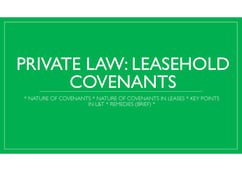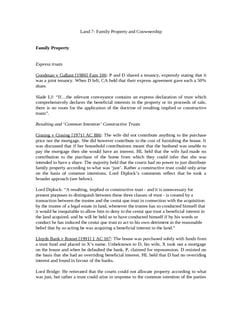Elitestone Ltd v Morris [1997] 1 WLR 687; [1997] 2 All ER 513
Judgement for the case Elitestone Ltd v Morris
Table Of Contents
KEY POINTS
In property law, the relationship between landlords and tenants is governed by rent restrictions and relevant statutes. Premises falling within these Acts delineate the parameters of rental agreements.
Wooden bungalows, when not attached to the land but not easily removable without demolition, raise questions about their status as part of the land. This distinction impacts issues such as maintenance, ownership, and tenant protection.
Under the Rent Act 1977 (c. 42), section J addresses such scenarios. It's crucial to determine if occupants of these bungalows qualify as protected tenants, entitled to statutory safeguards against eviction and unfair rent increases.
FACTS
-
Elitestone Ltd. (“Plaintiffs”) owned freehold land on which several wooden bungalows were erected, including one occupied by David Owen Morris and Judith Mary Sked (“Defendants”) under a "licence" agreement.
The agreement allowed the Defendants to keep and reside in the bungalow on the land in exchange for an annual payment.
The bungalow's main structure was supported by concrete pillars attached to the ground, making it removable only by demolition.
In 1991, the Plaintiffs initiated legal proceedings in the county court to obtain possession of the land, including from the Defendants.
The assistant recorder determined that the Defendants were protected tenants under Section 1 of the Rent Act 1977.
The Court of Appeal ruled in favour of the Plaintiffs on appeal, declaring that while the Plaintiffs owned the land, the bungalow was considered a chattel owned by the Defendants, granting the Plaintiffs entitlement to possession.
The Defendants subsequently appealed the decision.
JUDGEMENT
-
On appeal by the Defendants, it was held that the answer to the question of whether a structure became part and parcel of the land itself depended on the degree and purpose of annexation to the land.
It was determined that a house constructed in a manner that made its removal only possible through destruction could not have been intended to remain a chattel but must have been intended to be part of the real property.
Therefore, the assistant recorder's conclusions were deemed correct.
As a result, the decision of the Court of Appeal was reversed.
COMMENTARY
-
The case delves into the complexities of property law, particularly regarding the relationship between landlords and tenants.
It focuses on the unique considerations raised by wooden bungalows not firmly attached to the land.
Such structures challenge traditional understandings of property ownership and tenancy rights, particularly in cases where the bungalow's attachment to the land is irreversible without demolition.
-
Furthermore, the commentary underscores the significance of legislative provisions, such as Section J of the Rent Act 1977, in addressing the legal issues surrounding the status of bungalow occupants.
The determination of whether these occupants qualify as protected tenants carries significant weight, impacting their entitlement to statutory protections against eviction and unfair rent increases.
The subsequent discussion of the specific case involving the Plaintiffs and Defendants provides a practical illustration of these legal principles in action. The dispute over ownership and possession of the land, coupled with the Court of Appeal's initial ruling in favour of the plaintiffs, sets the stage for the defendants' subsequent appeal.
The case analyzes the judgment rendered on appeal, emphasizing the consideration of the degree and purpose of annexation in determining the bungalow's status as part of the land.
This legal reasoning ultimately lead to the reversal of the Court of Appeal's decision, affirming the assistant recorder's conclusion that the defendants were indeed protected tenants under the Rent Act 1977.
For Further Study on Elitestone Ltd v Morris

A collection of the best Landlord and Tenant notes the director of O...
Need instant answers? Our AI exam tutor is here to help.
Ask questions 🙋 Get answers 📔 It's simple 👁️👄👁️
Our AI is educated by the highest scoring students across all subjects and schools. Join hundreds of your peers today.
Get StartedSimilar Cases
Related Product Samples
These product samples contain the same concepts we cover in this case.
| Land Law | Leases Notes (77 pages) |
| Landlord and Tenant Law | Private Residential Notes (27 pages) |

